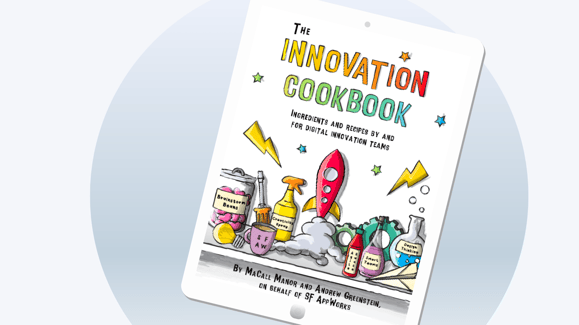The road to consistent innovation in an organization is notoriously difficult to map, which is why we started The Innovation Cookbook—a way for us to gather stories and perspectives from an array of people and industries. Our most recent guest, Scott Kirsner, has talked to quite a few more innovators than us, including executives like Jeff Bezos and leaders from countless organizations...Disney, Nike, Intel, and Starbucks, to name just a few.
Here’s what we learned from Scott Kirsner on innovation methodology:
1. Creating an innovative culture and delivering industry leading products on a sustainable basis can be especially tricky for large organizations. The few that manage are typically driven by a larger-than-life founder vision.

Photo by Hello I'm Nik on Unsplash
What do Steve Jobs, Jeff Bezos, and Walt Disney have in common? A ruthless and relentless mentality about finding new ways to grow. Even after the era of Walt Disney himself, leadership at the Walt Disney Company understood that in order to stay relevant to park and movie-goers, they needed to continue to push the boundaries of what was possible.
These kinds of companies have figured out how to fail less fearfully—or have at least developed a resilience to failure, continually spinning out new products and ideas. The success of the Amazon Fire Stick succeeded the relative failure of the Amazon Fire Phone.
2. Most companies think they're innovative.
It’s not uncommon for CEOs to comment on how innovative their company is, but the reality is that 95% of the human resources are about operating the core business or growing it incrementally. Other companies have a mentality that “everyone is innovative” within their organization, that anyone can have ideas and execute on them—something that Scott’s research hasn’t proved true.
While many companies look to set up innovation silos, sometimes at headquarters, and sometimes externally, the danger with siloing innovation externally is that often the effort isn’t well tied to headquarters or the core business initiatives. While prime for the press, these “innovative” projects and eye-catching technologies often prove little more than useful marketing material. Bells and whistles can spark the imagination, but are how will they change the world in a tangible sense?
3. In trying to understand why senior leadership looks to invest in innovation, two key questions present themselves: Is this helping generate new and additional revenues? Or, is this helping us save costs or operate more efficiently?
Although media buzz may serve a purpose with some degree of value, it’s further down the totem pole in terms of real significance for a company’s long-term trajectory of innovation.
4. Disney makes for a worthy case study on both disruptive and sustaining innovation.
- Disney not only continues to invest in its long-hailed Imagineering group, but also operates an academic research based effort to look even further ahead at possibilities that may not be relevant in the short term, as well as a program that seeks out partnerships with, and invests in startups.
- While many tech companies that consider themselves innovative exalt a work culture of young, fresh-minded recent graduates, Disney keeps its old-timers around––the company is mixed with people new and old, some who (in the early 2000s) had been a part of its evolution and can pass down stories about the founder.
Listen to the full episode here: Most Companies Think They're Innovative
Get a Free Copy of 'How To Measure Innovation'
.png?width=579&height=579&name=innovation%20metrics%20mockup%20(11).png)
5. Not surprisingly, startups understand persistence much better than large companies.
In big companies, most projects gain traction for a couple of years. If they don’t yield massive results after that time period, they fizzle out or get cut from budget. Kirsner describes this flawed cycle as a “short attention span.” Large companies can improve at spinning out products and ideas, even if it means letting an idea go or allowing a team to pursue it outside of the organization as a startup.
6. When asked about the internal vs external approach to innovation, Scott revealed that many companies operate an innovation effort internally, but that a common pitfall of this approach is doing so without clear intention behind who actually vets and validates those ideas.
7. Interestingly, the pharmaceutical industry sets a worthy example with its sophisticated approach to partnerships, new products, and pushing forward.

Photo by Obi Onyeador on Unsplash
[The Pharma industry] is really sophisticated in saying, 'we developed this drug and got it from the 20 yard line to the 80 yard line but we don't want to keep developing it further because we've changed our focus.' They will then license that drug to a startup that's interested in that condition, and often will keep a stake in it. They also tend to have really sophisticated relationships with startups.
These companies are constantly engaging with startups to understand new therapeutic approaches, demand, and how a drug can evolve. Says Kirsner, there’s a lot of innovation in the startup space, and companies can’t just watch it from a distance. You have to understand how you can relate to it or connect with it.
Get a free copy of 'How to Tackle a Website Redesign'
.png?width=579&height=411&name=website%20redesign%20(4).png)
8. Customers and salespeople are secret weapons in the innovation process.
- Develop ways to bring customers in early on so that they can communicate their key problems and thoughts on what’s being developed, and reveal what it is they need in a product.
- Often, testing takes place as an afterthought to a product’s launch - creating excess work and potentially wasting time.
9. There are important yardsticks for measuring innovation. Do employees feel they are given the tools and resources necessary to develop their ideas? Are their ideas being heard in the first place?
- A Vitality Index, a useful measurement tool, can indicate whether the products you rely on the most for revenue were created in the last three years.
- In software development, a vitality index can be used in terms of your software release cycles.
We wrapped up our conversation with Scott with a question about the pandemic. We wondered how it has accelerated or molded innovation, and what trends we might expect to see moving forward. The way in which companies support remote work and remote collaboration has begged the important question of how ideation and creativity can better find their way into these new virtual means of meeting with our colleagues.
Kirsner looks forward to how we may create new jobs for humans amidst the rise of AI automations, innovation surrounding work-life balance, culture, and education.
Related: 3 Dynamic Models of Innovation
Get a Free Copy of "The Innovation Cookbook"




COMMENTS